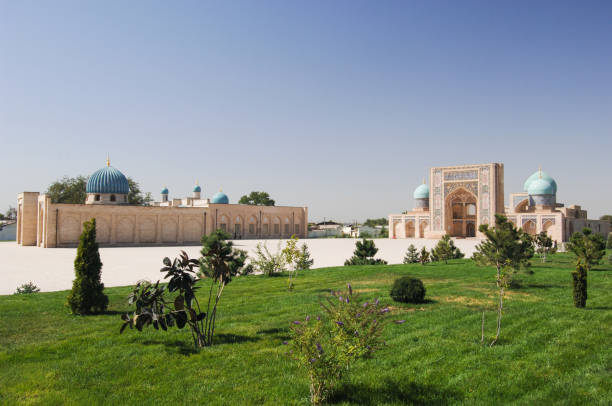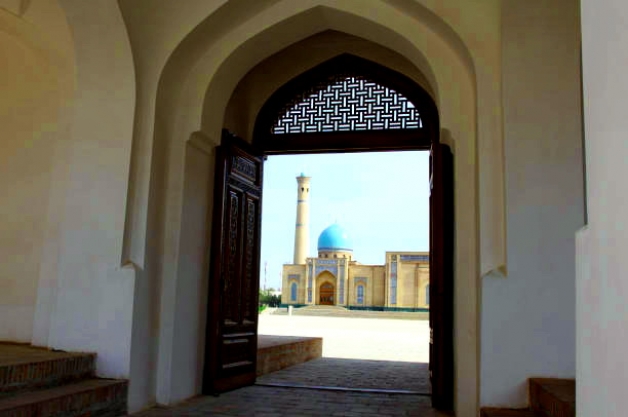Hast Imam - the religious center of Tashkent city
The religious complex in the old part of Tashkent, dedicated to the city's patron saint Kaffal al-Shashi, houses gems of Uzbekistan's architectural and spiritual heritage. Previously surrounded by residential buildings, the area was cleared during reconstruction, making its vibrant monuments visible even from a distance. Landscape design experts were involved in the renovation, harmoniously planning the space and adorning it with unique trees, plants, and flowers not typical for Uzbekistan. Yet, those seeking an authentic Uzbek mahalla experience can still find it here, just a short walk from Hazrati Imam Square.
The mausoleum of Kaffal al-Shashi
The mausoleum of Kaffal al-Shashi has grown over centuries around the burial site of Abu Bakr Muhammad Kaffal al-Shashi. He was a scholar of Sharia law, served under the caliph in Baghdad, and later in life chose to return to his homeland. At that time, Tashkent was embroiled in a war with pagans, on the brink of a bloody battle. The revered Imam, as he was known among the people, employed his intellect, political experience, and profound spiritual knowledge to find a resolution to the conflict without casualties. He succeeded in converting the pagans to Islam, skillfully handling this challenging task and thereby saving many lives. Since then, he has been considered the city's protector. Even after his death, people continue to visit his tomb to pray and seek his assistance in their troubles and concerns.
The Library with the Quran of Osman
In the heart of the Islamic heritage of the capital, on the territory of Hazrat Imam Square, stands a modest-sized building. In the 14th century, a Sufi khanqah of the Naqshbandi order stood here. Later, in the 16th century, one of the Kokand Khans transformed it into a library. Since then, the library has amassed 20,000 unique spiritual manuscripts, making it the largest in the Islamic world. At the helm of this library is the ancient Quran of Caliph Osman, dating back to the 7th century, with its original text.
This sacred Muslim text has been moved out of the country multiple times – from the early Middle Ages, there hasn't been a ruler who didn't wish to add this relic to their treasury. Amir Timur took it from Baghdad and kept it in the grandest structure of his empire – the Bibi-Khanum Mosque in Samarkand. In the 19th century, following the capture of the territories by the Russian Empire, the Quran was transported to the Imperial Library in St. Petersburg. There, a full-scale copy was created, and it remains preserved to this day. A group of scholars researched to verify its authenticity.
Now, the Quran of Caliph Osman is on display in the centre of the exhibition. It consists of 359 leather pages, with 12 lines on each page, without diacritical marks. Some pages have been replaced with paper, showing signs of ancient restoration. Visitors are required to remove their shoes, as in a mosque, and photography is not allowed.
The museum also houses unique examples of ancient manuscripts, ranging from large to tiny ones that fit in one's palm. Additionally, the library houses the most extensive collection of Quran translations in different languages, including versions in Braille for the visually impaired.
Barak-Khan Madrasa
Opposite the library stands the 16th-century Barak-Khan Madrassah, on the drum of its dome are inscribed verses by the poet Vasifi:
Oh, what a city! Even the meadows of paradise
Cannot be compared to ancient Shash.
And those who settle here for long,
Will forget forever the gardens of paradise.
Perhaps to die in Tashkent is better
Than to live anywhere else.

Vasifi was a student of Alisher Navoi, whom he impressed with his modesty and foresight. Once, his father, a friend of Navoi, brought him to a gathering where talented poets played muama – poetic riddles. Navoi presented his new riddle. The young man's father had read Navoi's freshly baked riddle to him the day before, which Navoi had shared, so he knew the answer. Did he blurt out, "I know, I know!"? No, he hesitated. He waited as others tried to solve the riddle and then composed his muama with the same answer as Navoi's. In this way, he responded to the great poet without revealing the secret. Navoi appreciated this and took Vasifi as his student.
His pen gifted us with a beautiful poem about Tashkent, which he wrote while serving as the court poet to the Shaybanids. He educated Barak Khan of the Shaybanids, and the ruler, who held a deep affection for his teacher, constructed a medrese for him to ensure he wouldn't lack for anything. In his medrese, the poet became a mudarris – a rector and authored a book that made him famous worldwide. "Pearls of History" is a remarkable collection of essays about the palace intrigues of the Timurids and Shaybanids, a witty, humorous, and engaging book. Twenty copies of the book were made during the poet's lifetime - even his teacher Navoi couldn't claim such an achievement.
"The Pearls of History" has been translated into many languages and remains engaging reading for those curious and passionate about the mysteries of the past.
In 1555, Vasifi died. He is buried next to the Hast Imam complex, while his devoted student and the ruler of Maverannahr, Barak Khan, rest in Samarkand's Registan Square.
This medrese sits at the heart of the religious centre, honouring the poet and remarkable individual. In 1868, an intense earthquake destroyed the old city and damaged the medrese. By the 1950s, restoration became urgent to prevent its complete decay. The renowned craftsman and architect Usto Shirin led the restoration. The great Usto Shirin contributed to the decor of Barak Khan's medrese, preserving its traditional style and harmonizing it with its historical roots.
Tilla-Sheikh Mosque
In 2007, the complex saw the revival of the intricately carved Tilla-Sheikh Mosque, featuring two towering minarets topped with stork nests. In 2007, the complex unveiled the restored Tilla-Sheikh Mosque, adorned with intricate wood carvings and crowned by two lofty minarets with stork nests. The project engaged Uzbekistan's top architects and artisans.
The Great Imam's Square is always bustling – locals come here even in the evenings to spend time with family on this sacred land filled with positive energy, admiring the medieval monuments illuminated by vibrant lighting.









